
Archery is the sport, practice, or skill of using a bow to shoot arrows. The word comes from the Latin arcus, meaning bow. Historically, archery has been used for hunting and combat. In modern times, it is mainly a competitive sport and recreational activity. A person who practices archery is typically called an archer, bowman, or toxophilite.

The Battle of Agincourt was an English victory in the Hundred Years' War. It took place on 25 October 1415 near Azincourt, in northern France. The unexpected English victory against the numerically superior French army boosted English morale and prestige, crippled France, and started a new period of English dominance in the war that would last for 14 years until England was defeated by France in 1429 during the Siege of Orléans.

The English longbow was a powerful medieval type of bow, about 6 ft (1.8 m) long. While it is debated whether it originated in England or in Wales from the Welsh bow, by the 14th century the longbow was being used by both the English and the Welsh as a weapon of war and for hunting. English longbows were effective against the French during the Hundred Years' War, particularly in the battles of Sluys (1340), Crécy (1346), Poitiers (1356), and Agincourt (1415). They were less successful later on, as longbowmen had their lines broken at the Battle of Verneuil (1424), although the English won a decisive victory there; they were completely routed at the Battle of Patay (1429) when they were charged by the French mounted men-at-arms before they had prepared the terrain and finished defensive arrangements. The Battle of Pontvallain (1370) had also previously shown longbowmen were not particularly effective when not given the time to set up defensive positions.

The Battle of Crécy took place on 26 August 1346 in northern France between a French army commanded by King Philip VI and an English army led by King Edward III. The French attacked the English while they were traversing northern France during the Hundred Years' War, resulting in an English victory and heavy loss of life among the French.
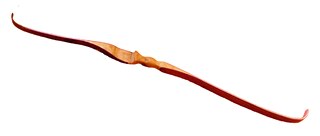
In archery, the shape of the bow is usually taken to be the view from the side. It is the product of the complex relationship of material stresses, designed by a bowyer. This shape, viewing the limbs, is designed to take into account the construction materials, the performance required, and the intended use of the bow.
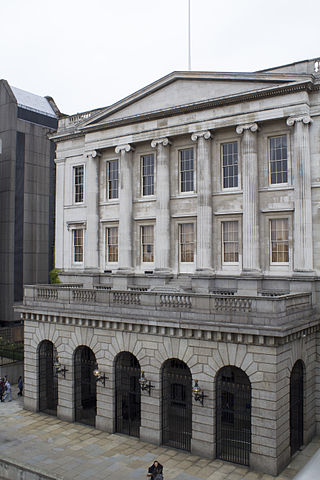
There are 111 livery companies, comprising London's ancient and modern trade associations and guilds, almost all of which are styled the "Worshipful Company of" their respective craft, trade or profession. These livery companies play a significant part in the life of the City, not least by providing charitable-giving and networking opportunities. Liverymen retain voting rights for the senior civic offices, such as the Lord Mayor, Sheriffs and Common Council of the City Corporation, London's ancient municipal authority with extensive local government powers.
The Worshipful Company of Scriveners is one of the 111 livery companies of the City of London. The Scriveners Company was originally known as the Mysterie of the Writers of the Court Letter and, since its incorporation, as Master Wardens and Assistants of the Company of Scrivenors of the Cittie of London [sic]. It is one of the few livery companies that from its foundation to the present day has been influential in setting the standards for a living profession, namely that of scrivener notary. The company's first ordinances were granted in 1373. Its royal charter was granted by King James I on 28 January 1617.
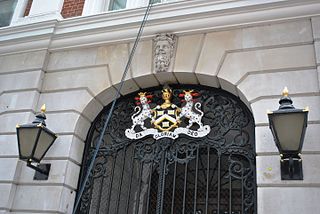
The Worshipful Company of Dyers is one of the Livery Companies of the City of London. The Dyers' Guild existed in the twelfth century; it received a Royal Charter in 1471. It originated as a trade association for members of the dyeing industry but is now mainly a charitable institution. Each year the company participates in the ceremony of Swan Upping along the River Thames.

The Worshipful Company of Masons is one of the ancient Livery Companies of the City of London, number 30 in the order of precedence of the 110 companies. It was granted Arms in 1472, during the reign of King Edward IV; its motto is “God Is Our Guide”.
The Worshipful Company of Fletchers is one of the livery companies of the City of London.
The Worshipful Company of Loriners is one of the ancient Livery Companies of the City of London. The organisation was originally a trade association for makers of metal parts for bridles, harnesses, spurs and other horse apparel; hence the company's name, which comes from the Latin word lorum through the French word lormier.
The Worshipful Company of Scientific Instrument Makers is one of the 111 livery companies of the City of London. It ranks 84th in the order of precedence for the livery companies.
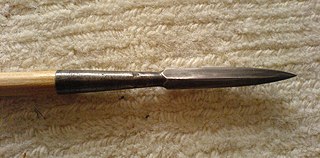
A bodkin point is a type of arrowhead. In its simplest form it is an uncomplicated squared metal spike, and was used extensively during the Middle Ages. The typical bodkin was a square-section arrowhead, generally up to 11.5 cm (4.5 in) long and 1 cm (0.39 in) thick at its widest point, tapered down behind this initial "punch" shape. Bodkin arrows complemented traditional broadhead arrows, as bodkin point arrows were designed to defeat mail armor while broadhead point arrows caused more serious wounds and tissue damage.
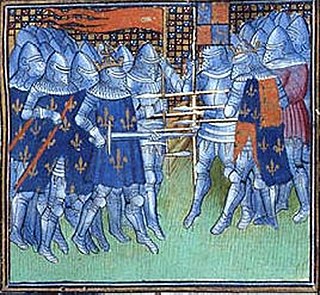
The Oriflamme, a pointed, blood-red banner flown from a gilded lance, was the sacred battle standard of the King of France and a symbol of divine intervention on the battlefield from God and Saint Denis in the Middle Ages. The oriflamme originated as the sacred banner of the Abbey of St. Denis, a monastery near Paris. When the oriflamme was raised in battle by the French royalty during the Middle Ages, most notably during the Hundred Years' War, no prisoners were to be taken until it was lowered. Through that tactic, they hoped to strike fear into the hearts of the enemy, especially the nobles, who could usually expect to be taken alive for ransom during such military encounters.

A longbow is a type of tall bow that makes a fairly long draw possible. A longbow is not significantly recurved. Its limbs are relatively narrow and are circular or D-shaped in cross section. Flatbows can be just as long, but in cross-section, a flatbow has limbs that are approximately rectangular.
The ransom of John II of France was an event during the Hundred Years War, between France and England. King John was captured by the English during the Battle of Poitiers in 1356, and held for ransom by the English crown. Finally settled in the Treaty of Brétigny in 1360, the ransom of John II had serious consequences for the ongoing degradation of the stability of France and helped increase English influence during the war.

Archery, or the use of bow and arrows, was probably developed in Africa by the later Middle Stone Age. It is documented as part of warfare and hunting from the classical period until the end of the 19th century, when it was made obsolete by the invention and spread of repeating firearms.

Despite the rise of knightly cavalry in the 11th century, infantry played an important role throughout the Middle Ages on both the battlefield and in sieges. From the 14th century onwards, there was a rise in the prominence of infantry forces, sometimes referred to as an "infantry revolution".
The Woodmen of the Ancient Forest of Arden are an exclusive society of longbow shooting toxophilites, founded in 1758 in the village of Meriden, in the Borough of Solihull, in the ancient Forest of Arden.

The Yeoman Archer is a term applied specifically to English and Welsh military longbow archers of the 14th-15th centuries. Yeoman archers were commoners; free-born members of the social classes below the nobility and gentry. They were a product of the English form of feudalism in which the military duty of a knight to his lord was replaced by paid, short-term service. By negating the tactical advantage of large numbers of cavalry with their ability to rapidly fire volleys of arrows, Yeoman Archers are considered part of the Infantry Revolution of the 14th century. The Battles of Crécy and Agincourt are the best known victories of the Yeoman Archers.













